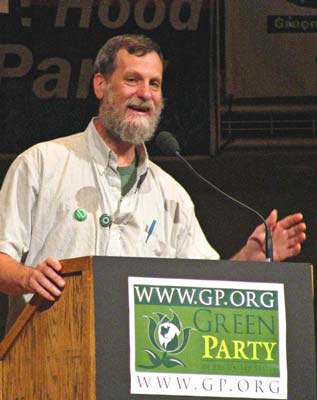Spotlight on a founding member
Share
 Greg Gerritt reflects on his life as a Green and his new direction
Greg Gerritt reflects on his life as a Green and his new direction
by Greg Gerritt, Green Party of Rhode Island and founding member of the Green Party in the United States
After 25 years of actively working within the Green Party apparatus in the United States, I have decided to step out of the bureaucracy and devote all of my Green Party time to working with Green candidates. My colleagues have asked me to reflect a bit on my work as a Green over those years, so here is the very short version.
I first heard about the Green Party when I learned of the initial success of the German Green Party in 1980. I immediately noted we needed a Green Party in the U.S. Early in 1984, John Rensenbrink and a few colleagues called the first Green Party (GP) meeting in the U.S. in Augusta, Maine. I did not know about that first meeting, but I went to the second meeting in February 1984, and until November 2008 I have been continually involved in some sort of Green Party bureaucracy.
†

"If the Green Party ever becomes the kind of political force we hope it will be, no one, absolutely no one, will be more responsible than Greg Gerritt." Richard Walton, Green Party of Rhode Island.
In 1986, I was the first Green in the U.S. to run for state legislature. It was the right-sized district for a shoe leather campaign, about 8200 people, and after knocking on about 90 percent of the doors in the district, I received 16 percent of the vote in a three party race, nearly winning in my own community and coming within 6 percent of placing second. To this day I maintain that state representative races, especially in states with relatively small districts, are excellent for Greens to win with shoe leather campaigns.
†
In my campaign, I focused on bad forest practices, a bad economy, and credibility on economic issues. The ability to demonstrate that a Green economy can lead to prosperity is what will determine our long-term success. Unless Americans believe a green economy works and can provide a decent living for them and their neighbors; we do not get elected. Good candidates address this daily.
In 1991, the Green National Gathering in Elkins, West Virginia, was a tumultuous affair. I was chosen to lead a committee coming out of this event that would explore what type of structure the GP should use for its national committee. In 1992 each committee member wrote an essay on what they thought would be best. I compiled the essays and submitted them. My suggestion was that we become a federation of state parties, with each state party being fairly autonomous. I maintained this was useful because it could partly compensate for the ridiculous array of election laws we face and would prevent a small number of state parties from controlling the whole party.
To this day, I maintain state representative races, especially in states with relatively small districts, are excellent for Greens to win with shoe leather campaigns.
The federation approach was continued when we transformed from the Association of State Green Parties to the Green Party of the United States. Although some Greens still advocate for individual membership, which would give California dominance, the association of state parties has proven to be a viable structure.
While the GP caught a wave with Ralph Nader in 2000, the world and the party has changed, and for 2008 we needed a candidate dedicated to the party. As a member of the Presidential Campaign Support Committee, I led efforts to educate the state parties and the potential candidates about the nomination process, and helped them prepare for a crazy year.
I was proud of the four candidates who made it to the convention, Jesse Johnson, Cynthia McKinney, Kent Mesplay, and Kat Swift, all of whom used their campaigns to build the party. I am also proud that my last major action for the Green Party was to lead the workshop at the national committee meeting the morning after the nomination to help our nominee, Cynthia McKinney, integrate her campaign into the party structure.
As I step away from the bureaucracy, my next Green project will be to create a consulting business called the Green Party Candidates and Campaign Resource Center. It will be a small network of experienced Green campaigners and former candidates who will work with Green candidates, campaign teams, and state parties to help them run better campaigns. I have already lined up a number of cooperators for this project, and, now that I no longer have any official positions, I am moving swiftly on the project, recruiting Green campaign consultants, and publicizing it so by the time the 2010 election season rolls around, many months from now for winter elections, we shall have a team in place, ready and able to help every Green candidate who can use it. It will have no bureaucracy and no nay-sayers and, after 25 years in the bureaucracy, I am really going to enjoy that.
Anyone who wants to be involved, drop me a line at gerritt@mindspring.com.




